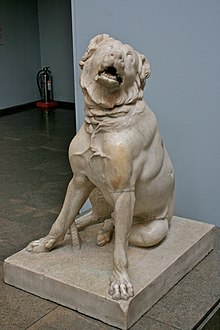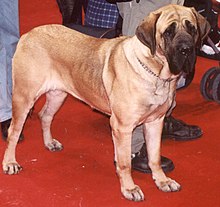Molosser
Molosser is a category of solidly built, large dog breeds that all descend from the same common ancestor. The name derives from Molossia,[1] a sub-region of ancient Epirus,[2] where the large shepherd dog was known as a Molossus.[3]
Origins
Function
Although some Molossers are used for search and rescue, such as the German Shepherd and the Saint Bernard, most are used as guard dogs, due to their deep voices and natural guarding instincts, or livestock guardian dogs for protection against large predators as well as poachers. Some breeds like the Greater Swiss Mountain Dog have also been used as cart dogs.
Development
The oldest known record of a Molosser-type dog is found in its name, which is the namesake of the people who first used these dogs: the ancient Greek tribe of Mollosians in Epirus. The people of Epirus were a seafaring people and these dogs sailed with their masters to Asia, where selective breeding gave them multiple phenotypes that were better suited to their new climates and roles.
As these ancient Molosser dogs were exported to West Asia, Central Asia, South Asia, and North Africa, they soon adapted to their surroundings and interbred with local dogs resulting in offspring with shorter, differently colored coats but retained more anatomical morphology traits like height and massive heads with short muzzles.
The dogs were considered valuable in Babylon, and are mentioned in cuneiform in the 4th century BC. A large mastiff-like dog is shown on the ancient terra cotta by Birs Nimrud. The dog is 90 centimetres (35 in) tall at the withers, has a stocky head and powerful hind quarters. The dogs were used for hunting in ancient Assyria. Archeological digs of the Ashurbanipal palace (7th century BC) revealed pictures of dogs felling wild horses and donkeys. Assyrian mastiffs were also used for military purposes and for protection.
The ancient mastiffs would later be imported from Assyria and Babylon to Egypt and Asia Minor. Xerxes I of Persia led predatory wars to enlarge the borders of his empire, taking with him large war dogs in his Army. Mastiffs were used to fight in the Roman amphitheater against lions and may have been used in lion hunting. They are the root of many Shepherd and Mountain dog breeds.
The Alans kept mastiff-like dogs taken from Eastern Europe which acted as retrievers, guard dogs, and fighting dogs. The name associated with these dogs is Alaunt, or in Spanish, Alano. The mastiffs were used in unison with sighthounds to hunt wisent, aurochs, and bear. Groups of Alanian tribes came to Europe during the Migration Period, fighting on the territory of modern Portugal, Spain, France, Italy, and North Africa, taking with them their dogs. The Alanian mastiffs then spread to the British Isles.[4] The mastiff of the Alps, the Alpine Mastiff, was a progenitor of the St. Bernard and contributed to the modern English Mastiff.
The Newfoundland dog is the only Canadian Molosser-type dog breed. Portuguese fishermen have fished off the shores of Newfoundland for centuries, and the Newfoundland breed was the result of Portuguese mastiffs breeding with St. John's water dog.
The Bulldog breeds split from the Molossers in Europe and spread to the New World with colonization. Though smaller, Bulldogs are considered still to be Molosser breeds.
In contemporary culture they are also known as Mastín (Spanish), Dogue or Dogo (Romance languages), and Dogge (Germanic).
Taxonomy
Nineteenth-century army veterinarian and entomologist Jean Pierre Mégnin theorized there were four basic canine races based on his observation of their different skull structures: Lupoides (Spitz), Braccoides (scenthounds), Graioides (sighthounds), and Molossoides (mountain dogs, mastiff breeds and even Pugs).[5] Although study of the canine genome is causing the revision of phenotype-based taxonomies such as Mégnin's, the four categories are still used in some traditional contexts.
Mastiff confusion
Breeds such as the Bullmastiff, Dogue de Bordeaux, Fila Brasileiro, Pyrenean Mastiff (Mastín del Pirineo), Spanish Mastiff, Neapolitan Mastiff, Tibetan Mastiff, and many others fall into the larger category of "Molossers", but are not "Mastiffs". Each is a separate and distinct breed.[6] The Boxer breed is also included, as it is a creation from other Molossers including the Old English Bulldog.
A Fila Brasileiro, showing the typical molosser build.




No comments:
Post a Comment